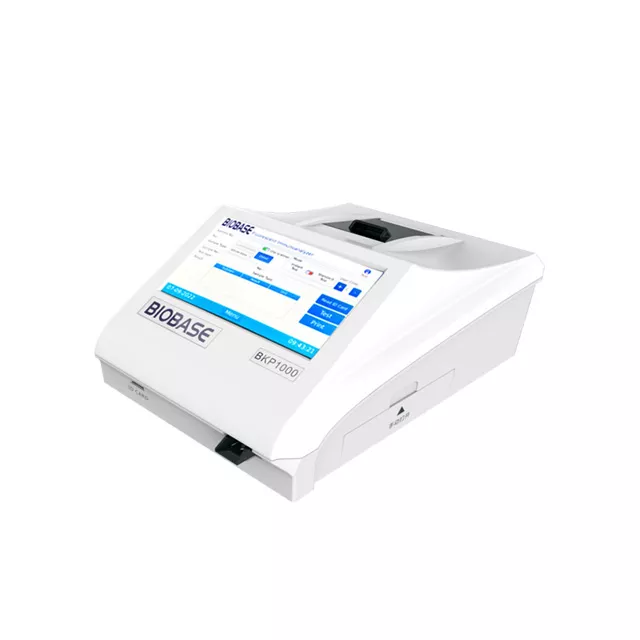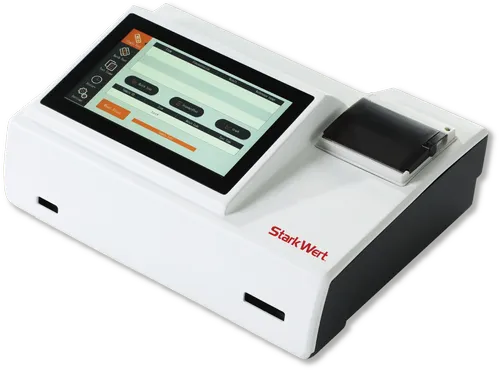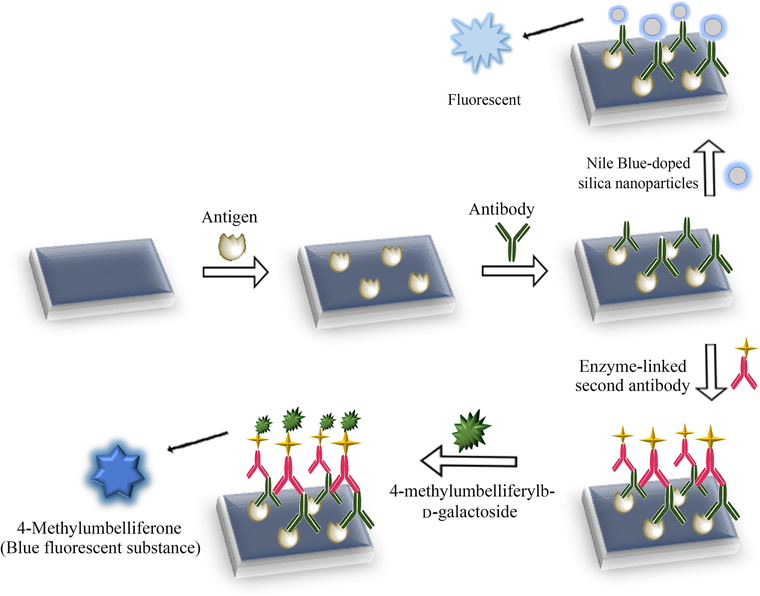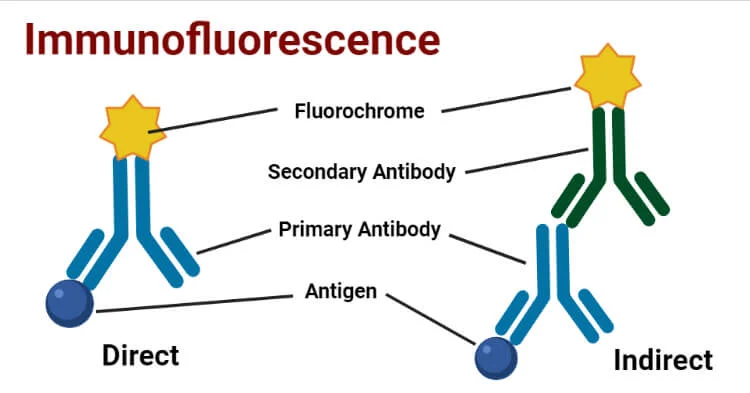
Introduction
- Immunoassays ek aisi analytical technique hai jo antigen aur antibody ke specific binding ka use karke biological ya clinical importance ke molecules ko detect aur quantify karti hai.
- 1960s me jab radioimmunoassay (RIA) develop hua tha, tab se immunoassay me bohot progress hui hai.
- RIA ke drawbacks (radioactive risk) ko avoid karne ke liye naye alternatives aaye, aur unme se ek fluorescent immunoassay (FIA) sabse zyada powerful tool ban gaya.

- FIA me fluorophores ka use hota hai radioisotopes ya enzymes ke jagah.
- Ye fluorophores light absorb karke ek aur wavelength par light emit karte hain.
- Is property ke wajah se antigen–antibody interaction ko highly sensitive tareeke se measure kiya ja sakta hai.
Definition
Fluorescent Immunoassay (FIA) ek laboratory method hai jisme specific biological molecules (antigen ya antibody) ko detect aur quantify karne ke liye fluorophore-labeled immunoreagents ka use hota hai.
-
Jab fluorophore-labeled antibody antigen se bind hota hai (ya vice versa), to us complex ko light ke ek specific wavelength se excite karte hain.
-
Phir woh fluorescent signal emit karta hai jo proportional hota hai target molecule ke concentration ke saath.
Isliye FIA ko define kiya ja sakta hai:
“Ek immunoassay jo fluorescent labels ka use karke antigen–antibody binding reactions ko detect aur measure karta hai, high sensitivity aur specificity ke saath.”
Principle
FIA ka principle immunological specificity, fluorescence, aur quantitative signal measurement par based hai.
1 Immunological Specificity
-
Antigens wo molecules hote hain jo immune response stimulate karte hain.
-
Antibodies ekdum specific way me antigen se bind hote hain (lock-and-key model).
-
Ye specificity FIA ke accurate results ke liye important hai.
2 Fluorescence
-
Fluorescence ek aisi property hai jisme ek molecule (fluorophore) ek wavelength ki light absorb karta hai aur ek badi wavelength ki light emit karta hai.
-
Example: Fluorescein blue light (~490 nm) absorb karta hai aur green light (~520 nm) emit karta hai.
-
Agar antibodies ya antigens fluorophore se tag kiye jayein to binding events ko visualize ya quantify kiya ja sakta hai.
3 Quantitative Detection
-
Fluorescence ki intensity directly proportional hoti hai antigen–antibody complex ke concentration ke.
-
Special instruments use hote hain jaise: fluorescence microscopes, flow cytometers, plate readers, aur spectrofluorometers.
Components
-
Antigen – Target analyte (jaise protein, hormone, pathogen, toxin).
-
Antibody – Specific immunoglobulin jo antigen se bind hota hai.
-
Fluorophore – Fluorescent label jo antibody ya antigen ke sath attach hota hai. Common fluorophores:
-
Fluorescein isothiocyanate (FITC)
-
Rhodamine
-
Alexa Fluor dyes
-
Cyanine dyes (Cy3, Cy5)
-
Quantum dots (nanoparticle fluorophores)
-
-
Detection System – Instrument jisme fluorescence measure hota hai (microscope, fluorometer, etc).
-
Solid Support (optional) – Jaise nitrocellulose, polystyrene beads, ya microplates jo immunoreagents ko immobilize karte hain.
Types
FIA ko assay design aur detection ke basis par alag-alag categories me divide kiya ja sakta hai:
1 Direct Fluorescent Immunoassay (DFA)
-
Antibody directly fluorophore se labeled hota hai aur antigen se bind karta hai.
-
Pros: Fast, kam steps.
-
Cons: Sensitivity kam hoti hai.
-
Example: Rabies virus ke detection ke liye DFA test.
2 Indirect Fluorescent Immunoassay (IFA)
-
Antigen pehle ek unlabeled primary antibody se bind hota hai.
-
Phir ek fluorophore-labeled secondary antibody primary antibody ko detect karta hai.
-
Pros: Zyada sensitivity kyunki multiple secondary antibodies ek primary pe bind hote hain.
-
Example: Autoimmune diseases me ANA detection.
3 Competitive Fluorescent Immunoassay
-
Sample ka unlabeled antigen aur fluorophore-labeled antigen antibody ke binding sites ke liye compete karte hain.
-
Jitna zyada unlabeled antigen hoga, utna fluorescence kam hoga.
-
Use: Small molecules (drugs, hormones, toxins).
-
Example: Cortisol measurement in serum.
4 Sandwich Fluorescent Immunoassay
-
Antigen ek immobilized antibody se capture hota hai.
-
Fir ek aur fluorophore-labeled antibody antigen ke doosre epitope se bind hota hai.
-
Pros: High specificity aur sensitivity.
-
Example: Viral proteins aur biomarkers detection.
5 Fluorescence Polarization Immunoassay (FPIA)
-
Principle: Small fluorescent antigens fast rotate karte hain aur light depolarized hota hai, jabki large antibody-bound antigen slow rotate karte hain aur polarized light emit karte hain.
-
Use: Drug monitoring (e.g., theophylline, cyclosporine).
6 Time-Resolved Fluorescent Immunoassay (TR-FIA)
-
Lanthanide fluorophores (Europium, Terbium) ka use hota hai jinki fluorescence delayed hoti hai.
-
Background autofluorescence ke baad measurement hota hai → bohot zyada sensitivity.
-
Application: Low-abundance biomarkers ka detection.
7 Multiplex Fluorescent Immunoassay
-
Alag-alag antibodies alag fluorophores ke sath tag kiye jate hain aur ek sample me multiple analytes detect kiye jate hain.
-
Example: Luminex technology – 50+ cytokines ek saath detect hote hain.
8 Flow Cytometry-Based FIA
-
Fluorophore-labeled antibodies cells ke antigens (surface ya intracellular) detect karte hain.
-
Laser excitation se single-cell level pe detection hota hai.
-
Use: Immunophenotyping, HIV CD4 count monitoring.
Applications
1 Clinical Diagnostics
-
Infectious Diseases: DFA for Rabies, Chlamydia, RSV.
-
Endocrinology: Hormones jaise insulin, T3/T4, cortisol.
-
Oncology: Tumor markers (PSA, CEA, CA-125).
-
Autoimmune: ANA test for lupus.
-
Hematology: Blood group antigen typing.
2 Biomedical Research
-
Immunofluorescence microscopy for protein localization.
-
Signaling pathway analysis.
-
Protein–protein interactions ka study.
-
High-throughput drug screening.
3 Pharmaceutical Industry
-
Drug monitoring (FPIA for antibiotics, immunosuppressants).
-
Pharmacokinetics aur pharmacodynamics.
-
Biomarker validation in clinical trials.
4 Food and Agriculture
-
Pathogens (Salmonella, E. coli) detection.
-
Allergen detection (gluten, peanut proteins).
-
Pesticide residues monitoring.
5 Environmental Monitoring
-
Toxins in water (cyanobacterial microcystins).
-
Soil aur water contamination check.
-
Endocrine disruptors detection.
6 Point-of-Care Testing
-
Portable FIA devices bedside testing ke liye use hote hain.
-
Examples: COVID-19 antigen kits, troponin test for heart attack, dengue antigen kit.
Advantages
-
High sensitivity (femtomolar–picomolar).
-
High specificity (antigen–antibody recognition).
-
Multiplexing capability (multiple analytes ek saath).
-
Wide dynamic range.
-
Non-radioactive (RIA se safe).
-
Versatility (microscopy, flow cytometry, microarrays).
-
Quantitative aur qualitative dono results.
Limitations
-
Autofluorescence (sample ka khud ka background signal).
-
Photobleaching (light se fluorophore damage).
-
Quenching (fluorescence intensity decrease due to interactions).
-
Expensive reagents aur instruments.
-
Skilled personnel required.
-
Cross-reactivity (false positives).
-
Hook effect (excess antigen → false low results).
-
Fluorophores ki stability issues (pH, temperature sensitive).
Recent Advances in FIA
-
Quantum Dots (QDs): Zyada bright aur stable nanoparticles.
-
NIR Fluorophores: Background noise kam, deep tissue imaging.
-
Microfluidic FIA: Portable lab-on-chip devices.
-
Smartphone-Based FIA: Mobile cameras se detection.
-
AI Integration: Automated image analysis.
-
Dual/Ratiometric FIAs: Accuracy zyada.
